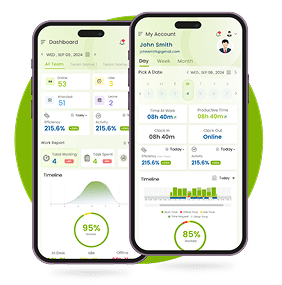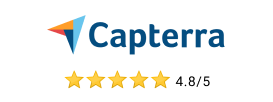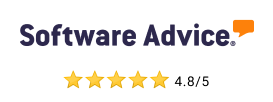In 2025, workplace wellness is no longer optional. As burnout increases and hybrid work becomes the standard, companies are taking a closer look at how they support employee health throughout the workday. Today’s wellness programs go far beyond gym memberships or snack perks. They include mental health resources, flexible work policies, digital wellbeing tools, and personalized support.
Time tracking software now plays a key role in promoting wellness. Tools like Desklog help identify signs of overwork, encourage healthy routines, and support daily balance without micromanagement. By integrating wellness into productivity systems, businesses are creating healthier work environments that support both employees and organizational success.
Overview:
- What Is a Workplace Wellness Program?
- Why Employee Wellbeing Matters in 2025
- Top Trends Shaping Employee Wellness Programs in 2025
- Employee Wellness vs. Corporate Wellness Programs
- Common Types of Workplace Wellness Programs in 2025
- How Desklog Elevates Employee Wellness in 2025
- How to Start and Implement a Workplace Wellness Program
- Practical Tips to Improve Workplace Wellbeing
- Benefits and Drawbacks of Workplace Wellness Programs
- The Future of Workplace Wellness
What Is a Workplace Wellness Program?
A workplace wellness program is a set of initiatives, strategies, and tools designed to promote the physical, mental, and emotional health of employees. In 2025, wellness programs are no longer fringe benefits, they are foundational to organizational success. These programs can range from fitness incentives and stress management workshops to advanced digital wellbeing platforms and mental health support systems.
Workplace wellness initiatives are aligned to meet the specific needs of an organization’s workforce. They aim to reduce health risks, improve productivity, increase engagement, and foster a supportive work culture. When implemented well, they also help reduce employee absenteeism and employee turnover.
Definition & Core Objectives
Workplace wellness programs are defined as organized employer-sponsored strategies that support healthy behaviors and improve employee outcomes both in and outside the workplace.
-
Promote holistic health: Including mental, physical, emotional, and financial wellness.
-
Prevent burnout and illness: By encouraging healthy habits and early interventions.
-
Boost productivity: Healthier employees are more engaged, motivated, and focused.
-
Support retention and morale: Wellness initiatives show employees they are valued.
-
Lower healthcare costs: Preventive care reduces long-term costs for both employer and employee.
Why Employee Wellbeing Matters in 2025
Wellbeing has evolved from a perk to a powerful business advantage. In an era defined by burnout and hybrid work, prioritizing employee health is essential for retention and growth.
- 77% of employees say wellbeing programs influence whether they stay with a company.
- Companies with strong wellness strategies see up to 30% lower turnover.
- For every $1 invested , businesses gain $5.50 in ROI from higher productivity and reduced absenteeism.
In 2025, thriving workplaces are those that prioritize wellbeing. They reduce stress, attract top-tier talent, and cultivate cultures of engagement, loyalty, employee satisfaction, and innovation.
Top Trends Shaping Employee Wellness Programs in 2025
AI-Powered Burnout Detection
Smart platforms like Desklog now analyze real-time behavior, flagging signs of stress or overwork before employee burnout hits. This allows for timely, proactive support.
Wellbeing Dashboards
Employees and managers gain personalized data on focus hours, screen fatigue, and mental load. Integrated with time tracking, these dashboards guide daily wellness improvements.
Hybrid Wellness Models
Companies blend on-site offerings (like ergonomic workspaces) with digital sessions for remote staff. Features like auto-scheduled mental health days balance workloads company-wide.
Digital Therapeutics & Mental Health Apps
On-demand tools like CBT programs, mindfulness chatbots, and guided meditations offer immediate support. Smooth integration keeps these tools secure and accessible within workflows.
Financial Wellness as a Core Pillar
Wellbeing in 2025 includes financial health, through tools for salary transparency, budgeting, and access to coaching or investment guidance.
Autonomy + Flexibility
Workplaces favor outcomes over hours. Features like async check-ins and meeting-free blocks empower employees to manage their wellbeing without sacrificing performance.
Employee Wellness vs. Corporate Wellness Programs
Both employee wellness and corporate wellness are essential components of a holistic wellbeing strategy. While one focuses on individuals, the other strengthens the organizational environment. Here’s how they differ and work together:
| Criteria | Employee Wellness Programs | Corporate Wellness Programs |
|---|---|---|
| Focus | Individual health and wellbeing | Organization-wide health strategies |
| Scale | Personal/Team-level | Company-wide |
| Example Initiatives | Step tracking, sleep improvement | Health insurance plans, EAPs, policy changes |
| Metrics | Energy, mood, measure employee productivity | Retention, absenteeism, healthcare costs |
| Ownership | Shared by employee & immediate manager | Driven by HR & senior leadership |
Employee wellness targets the day-to-day needs of individuals, while corporate wellness addresses structural support. When synchronized, both approaches improve employee accountability and wellbeing culture at every level.
Common Types of Workplace Wellness Programs in 2025
Workplace wellness in 2025 is no longer limited to gym perks or health checkups. It now embraces a holistic view of employee wellbeing; spanning physical, mental, financial, and even digital health. As companies adapt to hybrid and remote models, wellness programs are evolving to support the whole person, not just the worker.
Types of Wellness Programs:
Physical Wellness
On-site/remote fitness sessions, gym memberships, ergonomic support
Mental Health Support
Therapy access, meditation apps, burnout education
Financial Wellness
Budgeting tools for project cost overruns, financial planning webinars, debt management assistance
Social Wellbeing
Team-building events, interest-based communities, inclusive culture programs
Nutritional Health
Meal planning assistance, healthy office snacks, virtual cooking classes
Digital Wellness
Screen-time management, notification breaks, mindfulness tech
The most effective wellness programs in 2025 are flexible, inclusive, and tech-enabled. By offering support across multiple wellbeing dimensions, employers are not only improving productivity but also building healthier, happier, and more resilient teams.These initiatives also support effective team time management and time mapping in distributed teams.
How Desklog Elevates Employee Wellness in 2025
Desklog goes beyond traditional time tracking, helping modern, hybrid teams stay energized, focused, and well. Here’s how it supports a culture of sustainable performance through intelligent wellness integration:
Desklog empowers organizations to prioritize employee health without disrupting performance. Its wellness-focused tools are designed to proactively prevent burnout, reduce digital fatigue, and improve sustained focus; all woven into the natural rhythm of a workday.
Key Contributions
Employee Wellness Module
Desklog’s Employee Wellness Module is designed to make recovery a natural part of the workday through structured wellness support:
- Customizable Break Types: Employees receive guided short and long breaks customized for hydration, stretching, posture resets, or deep breathing, configured to match actual workload intensity.
- Flexible Participation Settings: Admins can enforce or make breaks optional, set skip rules, and define thresholds for when wellness interventions should appear, ensuring the right balance of structure and flexibility.
- Wellness Check-Ins:With mood tracking and personal wellness goals, employees can reflect on their wellbeing and progress, while maintaining full privacy.
- Insightful Analytics: Wellness usage patterns, break adherence, and engagement levels are available to admins, making it easier to promote wellbeing without micromanagement.
This module encourages healthier routines without disrupting productivity, turning small daily habits into long-term resilience.
Smart Break & Overtime Notifications
Desklog’s break & overtime notifications is to help maintain cognitive clarity and physical wellbeing, Desklog uses behavior-aware timing to prompt restorative pauses:
- Focus-Based Break Nudges: After 1.5 to 2 hours of continuous activity, employees receive a gentle prompt encouraging them to take a break ideal for stretching, hydrating, or resting their eyes. These prompts respond to real working patterns, not just static timers.
- Scheduled Break Reminders: Organizations can configure periodic short and long breaks, helping create consistency in recovery habits throughout the day.
- Overtime Alerts: Employees who exceed expected work hours receive overtime notifications, supporting work-life balance and giving managers visibility into workload imbalance.
- Admin Insights: Teams can monitor work patterns, break frequency, optimize employee efficiency and overtime trends through visual analytics making it easier to spot fatigue risks early.
These alerts don’t just signal breaks, they build awareness around sustainable effort, encouraging smarter work rather than longer hours.
Engaged Inactivity Tracking
Not all productivity happens at the keyboard. Desklog’s Engaged Inactivity Tracking detects periods of genuine work even during mouse-free moments like video calls, document reading, or focused planning. Instead of marking these as idle, Desklog captures them as valid, purposeful activity.
Admins can customize which apps and categories qualify as engaged inactivity, ensuring time logs align with each team’s work style. Reports then reflect these moments accurately removing the pressure of constant interaction and promoting trust-based accountability.
This feature recognizes modern workflows, validating deep thinking as part of productive output and also reinforces role of time tracking as a tool for trust, not surveillance
Wellness-First Productivity Reports
Desklog’s productivity reports are designed with wellbeing at the core. They blend traditional performance metrics with indicators of overload and burnout risk offering a more holistic view of how work gets done.
Employees see their own trends in focus time, context switching, and overtime, helping them self-adjust. It tracks employee engagement, fatigue, and workload balance and helps managers receive role-based, anonymized insights to identify imbalance before it becomes burnout, no surveillance, just support.
These reports empower both individuals and teams to improve productivity with empathy, not pressure.
How to Start and Implement a Workplace Wellness Program
Launching a workplace wellness program isn’t about quick fixes, it’s about building a long-term, people-first strategy. A thoughtful approach ensures the program truly meets your team’s needs and drives measurable impact.

1Needs Assessment
Start by understanding what your team actually needs. Use employee surveys, HR data, one-on-one feedback, and manager insights to identify key pain points, whether it’s burnout, physical fatigue, poor focus, or lack of social connection. A data-driven diagnosis sets the foundation for relevant, impactful wellness design.
2Goal Setting
Set clear, measurable objectives that align with your business and people goals. For example: “Reduce reported burnout by 30% in the next 6 months” or “Increase weekly break adherence by 50%.” Tangible goals not only justify investment but also help track success over time.
3Program Design
Choose wellness initiatives that suit your company’s values, workflows, and team composition. This could include tools like Desklog’s Employee Wellness Module, gym memberships, mental health days, ergonomic assessments, or team challenges. Incorporate a mix of physical, mental, and digital wellness interventions to support all dimensions of well-being.
4Rollout Strategy
A successful program launch requires more than an HR email. Create awareness with engaging internal campaigns, run a pilot with diverse employee groups, and appoint wellness ambassadors across departments. Make sure leadership participation is visible to boost adoption and credibility.
5Ongoing Evaluation
Wellness programs aren’t “set and forget.” Use tools like Desklog to track participation, identify overwork trends, and gather employee feedback. Regularly review the data to refine activities, update goals, and ensure the program evolves with your workforce needs.Monitor real-time data to support workload distribution and adapt for growth.
Practical Tips to Improve Workplace Wellbeing
Workplace wellbeing doesn’t have to start with massive budgets or corporate wellness retreats. The most impactful improvements often come from consistent, thoughtful changes in day-to-day operations. Below are categorized strategies both low-cost and tech-driven that any company can begin implementing today.
Mental Wellbeing
- Encourage microbreaks and time management discipline during long shifts to prevent mental fatigue and decision burnout. Even 5-minute pauses between tasks can reset cognitive energy.
- Promote asynchronous communication so employees aren’t tethered to constant pings or pressured to respond immediately. This reduces stress and supports focused work.
- Implement mental health day policies, clearly separate from sick leaves, to give employees space for rest, therapy, or emotional reset without stigma.
- Use tools like Desklog to detect burnout signals such as excessive overtime or skipped breaks, allowing early intervention and proactive support.
Physical Wellbeing
- Host regular stretching sessions or walking meetings to break sedentary patterns and improve circulation.
- Offer ergonomic guidance for both remote and in-office setups, minimizing long-term physical strain.
- Use Desklog’s Smart Break Reminders to prompt hydration, eye relaxation, and movement based on real-time work activity.
Emotional & Social Wellbeing
- Hold wellness check-ins, separate from performance reviews, to open space for employees to share how they’re feeling, not just how they’re performing.
- Recognize and reward healthy work habits like taking full lunch breaks, modeling balance, or helping teammates manage stress, not just high output.
- Train managers to be wellness advocates, equipped to identify distress, model balance, and create psychologically safe environments.
Benefits and Drawbacks of Workplace Wellness Programs
Benefits
Increased employee morale and loyalty
Wellness programs show employees they’re genuinely valued, fostering a stronger sense of belonging. This emotional connection often results in better team cohesion and long-term retention.
Reduced healthcare costs and absenteeism
Encouraging preventive care and healthy habits leads to fewer sick days and claims. Companies see a direct reduction in insurance premiums and unplanned productivity loss.
Higher focus, output, and work satisfaction
Regular breaks and mental health resources improve cognitive clarity and motivation. Employees are more present, engaged, and energized throughout the workday.
Stronger employer branding
Wellness-driven companies attract top talent and boost their reputation in the market. It positions the organization as progressive, caring, and employee-centric.
Drawbacks
Poorly executed programs may feel performative
Without authentic effort, wellness initiatives can seem like box-checking exercises. This may erode trust and cause disengagement rather than improving morale.
Privacy concerns if wellness tracking isn’t handled ethically
Monitoring mental or physical health requires clear policies and opt-in transparency. A lack of clarity can lead to fear of misuse and decreased employee participation.
One-size-fits-all programs can alienate diverse employee needs
Uniform initiatives may overlook cultural, physical, or psychological differences. True inclusivity requires flexibility in wellness offerings and communication.
Requires ongoing management, time, and resource investment
Launching a wellness program is not a one-time task, it needs constant iteration. Dedicated teams, feedback loops, and budget allocation are key to long-term impact.
The Future of Workplace Wellness
Workplace wellness is no longer just a perk, it’s becoming a strategic pillar for how modern organizations operate. As work evolves, so will the tools, insights, and philosophies that drive healthier, more balanced teams.
Predictive Wellness Analytics
Organizations will use data to proactively identify signs of burnout, stress, and disengagement. Trends like excessive overtime or skipped breaks will trigger early interventions. This shift from reactive to preventive wellness will redefine HR’s role.
AI-Driven Interventions
Real-time wellness prompts powered by AI will guide healthier habits during work. Tools like Desklog’s Smart Break Reminders respond to fatigue patterns with hydration, stretch, or screen break nudges. These interventions align wellness with actual work behavior.
Hyper-Personalized Programs
Future wellness initiatives will cater to each employee’s rhythm, role, and needs. From customized break types to custom recovery suggestions, programs will scale personalization. This improves adoption while respecting diverse work styles and health baselines.
Wellness as a Business KPI
Companies will begin treating employee wellbeing as a key performance indicator. Metrics like break adherence, mood trends, and wellness goal tracking will be actively monitored. This makes wellness measurable, strategic, and tied to organizational outcomes.
Culture-First Wellbeing Design
Wellness won’t be just an initiative, it will shape how teams operate. Async communication, no-meeting zones, and downtime policies will become part of daily workflows. A strong wellbeing culture supports productivity without burnout.
In Summary
Workplace wellness in 2025 is about creating a healthier and more balanced way of working. Organizations must shift from surface-level perks to meaningful support systems that address physical, mental, and emotional needs. With the right tools and thoughtful planning, companies can build wellness programs that support real work habits, reduce stress, and improve overall job satisfaction. Putting employee wellbeing at the center of how work happens is no longer a nice-to-have, it’s how strong, healthy teams are built.
Your Search For The Ultimate Employee Efficiency Tracker Ends Here.
FAQ
1 How has workplace wellness evolved in 2025?
Wellness programs have moved beyond perks to become essential workplace strategies. They now include AI-based burnout detection, personalized mental health tools, and time tracking software that helps maintain daily balance. The focus has shifted from participation rates to real, measurable wellbeing outcomes.
2 Why are wellness programs important in 2025?
With hybrid work and rising stress, wellness programs help prevent burnout, improve engagement, and boost retention. They’re also linked to higher productivity and lower healthcare costs.
3 What are the key components of a modern wellness program?
Effective programs cover physical health (e.g., fitness breaks), mental health (e.g., therapy access), financial wellbeing, and digital balance tools. Flexibility, personalization, and inclusivity are core to their design.
4 How does time tracking software improve employee wellbeing?
Modern tools like Desklog help monitor work patterns, suggest timely breaks, and track overtime or focus loss. This supports healthy routines without micromanagement.
5 Are workplace wellness programs actually effective?
Yes. Research shows that for every $1 spent, companies see up to $5.50 in returns through reduced absenteeism, improved morale, and greater focus.
6 What’s the difference between employee and corporate wellness?
Employee wellness is individual-focused (e.g., energy, mood, sleep), while corporate wellness involves company-wide efforts like policy changes, health plans, and leadership training. Both should align for lasting impact.
7 How can companies measure the success of a wellness program?
Success can be tracked using wellness dashboards, employee feedback, break adherence rates, and reductions in stress or turnover. Tools like Desklog provide real-time, actionable insights.
8 Do employees have to participate in wellness programs?
Most programs are optional but encouraged. The best ones are designed to fit various work styles and personal preferences, making participation more natural.
9 What trends are shaping wellness programs in 2025?
Key trends include AI burnout detection, mental health apps, financial coaching, async workflows, hybrid wellness models, and personalized wellbeing routines.
10 How can small businesses start a wellness program?
Start simple: conduct a quick employee survey, introduce guided break reminders or mental health days, and use low-cost tools like Desklog to promote healthy work habits gradually.















